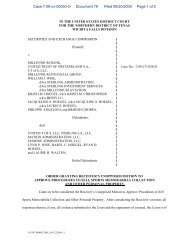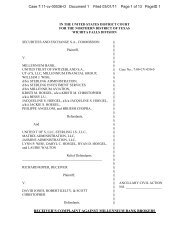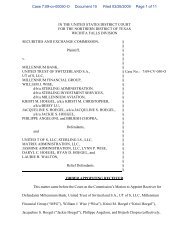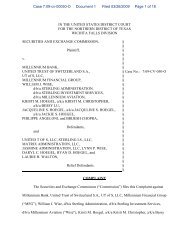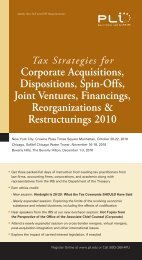View the full text of this document - Martindale.com
View the full text of this document - Martindale.com
View the full text of this document - Martindale.com
Create successful ePaper yourself
Turn your PDF publications into a flip-book with our unique Google optimized e-Paper software.
DYKEMA<br />
Establishing <strong>the</strong><br />
Corporate Defense<br />
best practices<br />
The pace and breadth <strong>of</strong> mass tort litigation<br />
situation<br />
continues to expand. As a result, in-house<br />
counsel at large national or multinational<br />
corporations are increasingly faced with <strong>com</strong>plex, voluminous,<br />
multidistrict product liability lawsuits involving personal injury, property<br />
damage and/or economic loss.<br />
in-house counsel<br />
challenge<br />
Crafting an aggressive corporate defense,<br />
whe<strong>the</strong>r it’s a relatively isolated matter or a<br />
bet-<strong>the</strong>-<strong>com</strong>pany case, requires identifying<br />
and ga<strong>the</strong>ring case-specific facts, <strong>document</strong>s and input from witnesses<br />
and expert witnesses; and ensuring that highly technical issues are<br />
translated into concepts that are easy for a jury to understand.<br />
implementation steps<br />
• Identify affected divisions/business units.<br />
• Create a product time line that identifies important facts,<br />
witnesses and <strong>document</strong>s.<br />
• Interview key internal contacts and opposing witnesses.<br />
• Review transcripts for testimony that supports your case.<br />
• Ga<strong>the</strong>r case-related <strong>document</strong>s.<br />
• Test and refine your story.<br />
• Choose/prepare expert witnesses.<br />
approach<br />
adopted<br />
The defense process starts by assessing <strong>the</strong><br />
<strong>com</strong>pany’s current standing in terms <strong>of</strong> facts,<br />
product history, witnesses and internal <strong>document</strong>s.<br />
Begin by identifying <strong>the</strong> affected division or divisions and retrieving<br />
all applicable organization charts. This will help you 1) determine<br />
how <strong>the</strong> organization was structured when <strong>the</strong> product was developed,<br />
2) identify key players who may ultimately serve as witnesses and<br />
3) identify where important <strong>document</strong>s are stored. If product<br />
development dates back 10 or more years, chances are <strong>the</strong> organization<br />
has changed—perhaps dramatically.<br />
Then, build a product time line, which will help establish and prioritize<br />
<strong>the</strong> facts <strong>of</strong> <strong>the</strong> case. The goal is to create a fact chronology. How<br />
did <strong>the</strong> product design play out? What departments and individuals<br />
were involved? Were <strong>the</strong>re any early issues or problems? And if so,<br />
how were <strong>the</strong>y resolved?<br />
Include disputed facts and previous litigation, if <strong>the</strong>re are any. Make <strong>the</strong><br />
time line as detailed as possible because you will refer back to it <strong>of</strong>ten.<br />
Does <strong>the</strong> past or current litigation involve <strong>the</strong> same product or issue?<br />
Are <strong>the</strong>re similarities in <strong>the</strong> plaintiffs? Which firms are bringing <strong>the</strong>se<br />
cases? The time line will bring all <strong>the</strong>se issues out into <strong>the</strong> open.<br />
The process will also help identify key internal players, develop a<br />
potential defense strategy and hone your discovery objectives. Once<br />
you arrive at a defense strategy, it’s far easier to get internal people<br />
to talk to you. Then you can review deposition transcripts—including<br />
opposing witnesses—to uncover testimony that supports your strategy.<br />
Apply <strong>the</strong> same approach to e-discovery. You want and need <strong>the</strong><br />
discovery and discovery response to be strategic. Considering <strong>the</strong> cost,<br />
you need to know what you’re looking for, versus mass <strong>document</strong><br />
retrieval. Use <strong>the</strong> time line and plan your discovery and response<br />
accordingly.<br />
Draft <strong>the</strong> corporate story and test it. Start at <strong>the</strong> trial stage and work<br />
backward. Ask, “Do we have enough pieces to put toge<strong>the</strong>r our story<br />
for <strong>this</strong> trial? Or are <strong>the</strong>re still holes in <strong>the</strong> time line?” Continue to<br />
massage <strong>the</strong> story until it is simple enough for any jury to understand.<br />
Once <strong>the</strong> defense is established, review your expert witness list. If<br />
you’ve done your homework, you’ll know which experts are a good<br />
fit. Then coach <strong>the</strong>m to ensure <strong>the</strong>y will address <strong>the</strong>ir topics exactly<br />
<strong>the</strong> same way every time, regardless <strong>of</strong> where <strong>the</strong> case is tried.<br />
measuring<br />
success<br />
Creating <strong>the</strong> corporate story requires a<br />
<strong>com</strong>prehensive review <strong>of</strong> all product-related<br />
<strong>document</strong>s, witness interviews and caserelated<br />
facts, both good and bad. This legal “audit” is <strong>the</strong> road map<br />
that will help inside counsel ascertain <strong>the</strong> strength (or weakness) <strong>of</strong><br />
<strong>the</strong> <strong>com</strong>pany’s position and craft its defense strategy accordingly.<br />
Sherrie L. Farrell, a litigator and member<br />
in Dykema’s Detroit <strong>of</strong>fice, coordinates<br />
and provides discovery strategies for<br />
<strong>com</strong>panies involved in multidistrict<br />
litigation and mass tort claims. She can<br />
be reached at sfarrell@dykema.<strong>com</strong>.<br />
JULY 2007<br />
13



